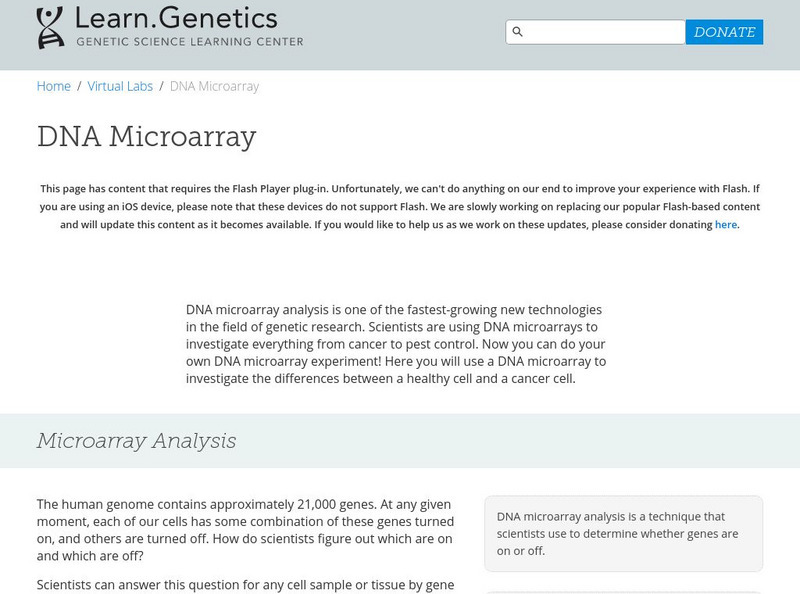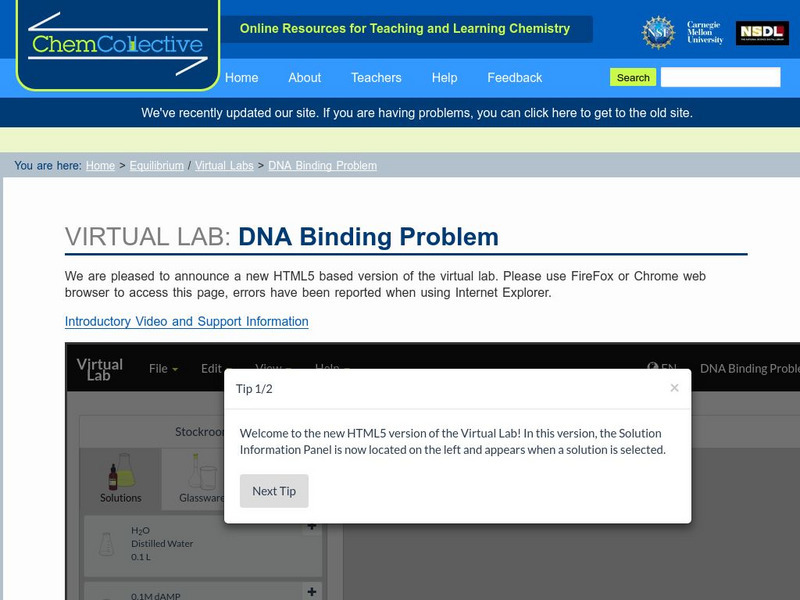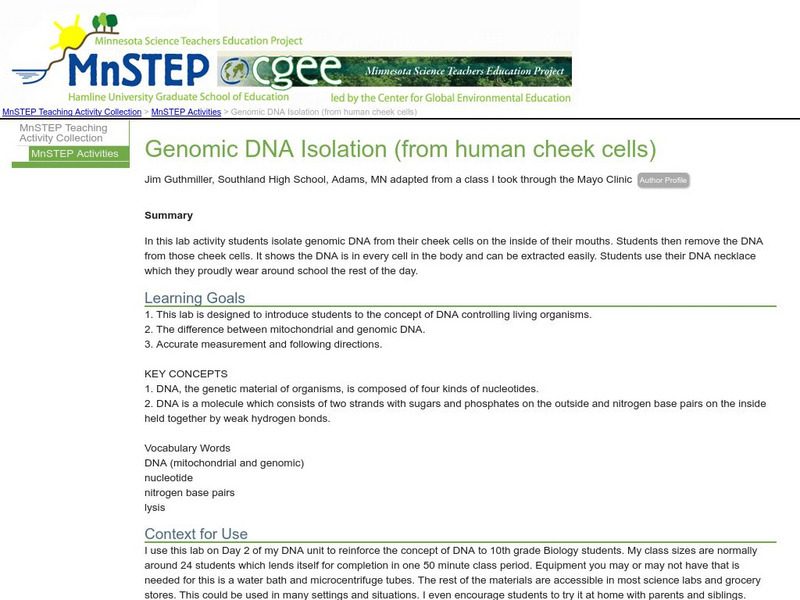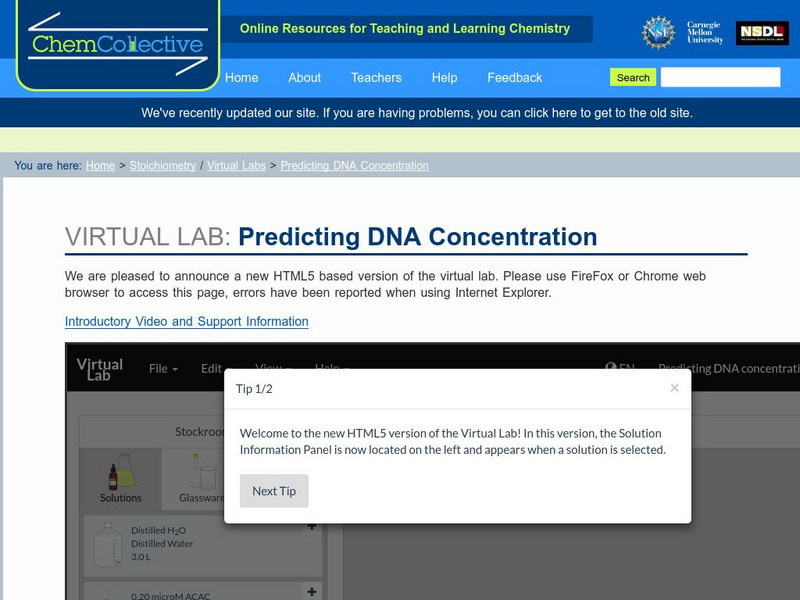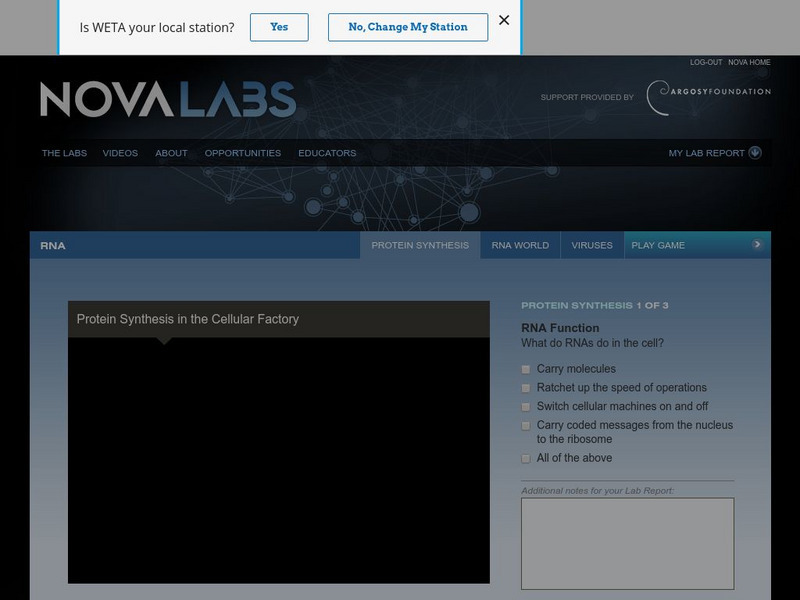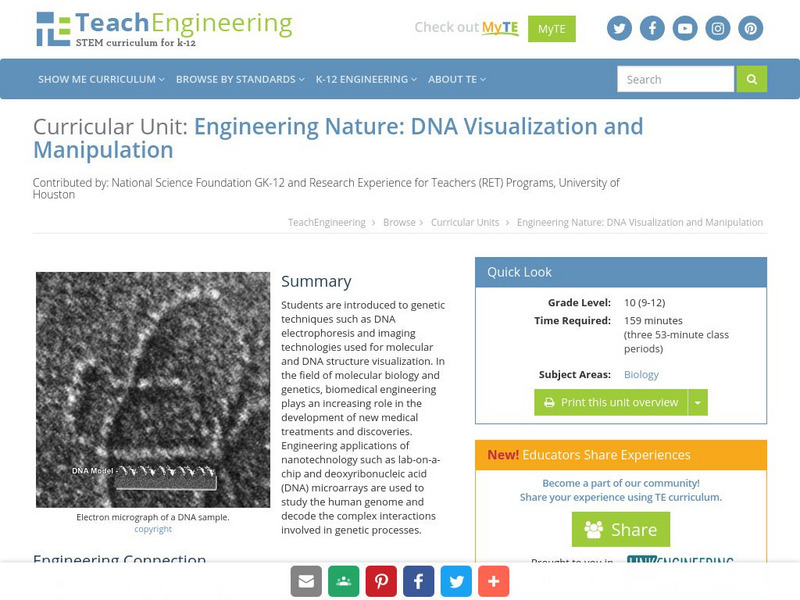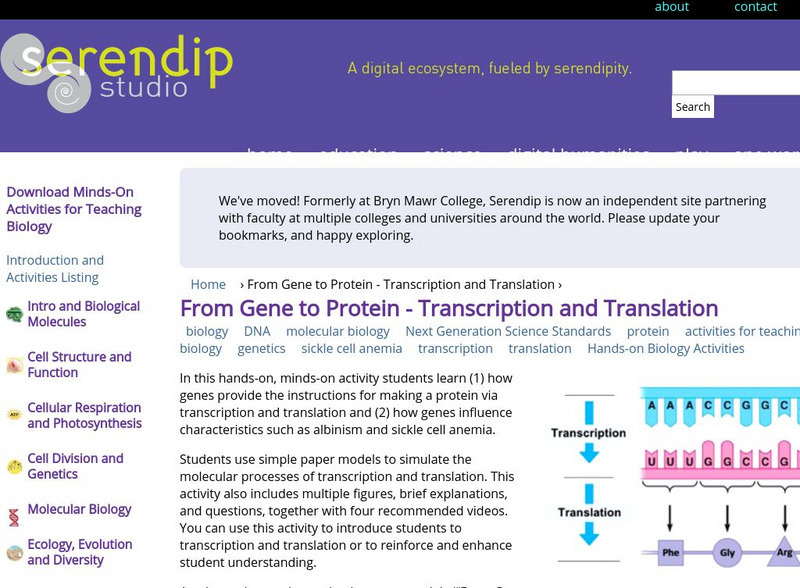Cold Spring Harbor Laboratory
Harlem Dna Lab: Bacterial Transformations
In this lab, students will transform E. Coli bacteria to be resistant to ampicillin and to glow green. Students will use genetic engineering techniques to insert plasmids into the bacteria. The site contains background reading,...
University of Utah
University of Utah: Dna Mircoarray Virtual Lab
This interactive lab will enhance learning about DNA by virtually translating a gene.
Chemistry Collective
Chem Collective: Unknown Concentration of Dna Solution Problem
In this advanced limiting reagent problem, students use the virtual lab to determine the concentration of a solution of DNA by reacting it with known amounts of a fluorescent dye which binds to the DNA.
Chemistry Collective
Chem Collective: Dna Binding Problem
In this activity, students explore equilibrium constants in biochemical systems by measuring the binding constant of a DNA-Dye reaction.
Carnegie Mellon University
Chem Collective: Dna Binding Dyes Scenario
This activity explores the equilibrium of dyes that self-assemble into DNA templates. Students use knowledge of equilibrium and quantitative spectroscopy to explore different dyes that bind selectively to DNA molecules. In this activity,...
Smithsonian Institution
Lemelson Center: Spark!lab: Extract Dna
Dissect strawberries and use common household ingredients to successfully extract and examine the strawberry DNA.
Concord Consortium
Concord Consortium: Molecular Workbench: Modeling Dna Hybridization
View this simulation of DNA Hybridization.
National Health Museum
Access Excellence: Dna Dry Lab
This lab illustrates how the order of nucleotides in DNA determines the order of amino acids in proteins. Relates DNA function to that of RNAand provides an exercise to demonstrate how mutations may occur. Includes a lesson plan and...
National Health Museum
Access Excellence: Wolf Pack in a Bottle: Dna Simulation
This lesson plan can be used to illustrate the principle of electrophoresis without the equipment. Paper chromatography can be used to separate dye just like electrophoresis will separate DNA. The lab also covers DNA analysis for an...
Science Education Resource Center at Carleton College
Serc: Introduction to Dna Extractions
This is a lab exercise giving instructions for the extraction of DNA from several different starting materials.
Science Education Resource Center at Carleton College
Serc: Genomic Dna Isolation: From Human Cheek Cells
In this lab activity learners isolate genomic DNA from their own cheek cells. They then remove the DNA from those cheek cells through a laboratory process.
American Museum of Natural History
American Museum of Natural History: O Logy: Stuff to Do: Dna in a Blender
Follow these illustrated instructions to conduct a simple experiment in separating DNA from an onion!
Chemistry Collective
Chem Collective: Determining Reactants and Products in a Solution of Dna
In this limiting reagents problem, students are given specific concentrations of DNA solutions and are asked to predict what products and reactants will remain after a specific volumes are mixed and reaction has occurred.
Chemistry Collective
Chem Collective: Predicting Dna Concentration
In this limiting reagents problem, students are given specific concentrations of DNA solutions and are asked to predict what products and reactants will remain after a specific volumes are mixed and reaction has occurred.
PBS
Pbs: Nova Labs: Protein Synthesis in the Cellular Factory
Watch short animations, read informational text, and make hypotheses about different aspects of protein synthesis.
TeachEngineering
Teach Engineering: Engineering Nature: Dna Visualization and Manipulation
Students are introduced to genetic techniques such as DNA electrophoresis and imaging technologies used for molecular and DNA structure visualization. In the field of molecular biology and genetics, biomedical engineering plays an...
Chemistry Collective
Chem Collective: Dna Dye Binding: Equilibrium and Buffer Solutions
Students examine equilibrium and buffer solutions in a biological setting.
Cold Spring Harbor Laboratory
Dolan Dna Learning Center: Model Organisms
Learn about model organisms that research scientists use in lab testing.
Howard Hughes Medical Institute
Hhmi: Bio Interactive: Leading Edge Bioinformatics
Peter Skewes-Cox, and Dr. Graham Ruby, both in the DeRisi lab, explain state-of-the-art DNA sequencing and bioinformatic technologies. [6:36]
Concord Consortium
Biologica: Web Lab, Mendel's Peas
At this site see an online visual of meiosis, fertilization, and inheritance and play a game.
Bryn Mawr College
Serendip: From Gene to Protein Transcription and Translation
Brief text summary of what students learn in the Dragon Genetics II lab along with links to download Student Handouts in PDF and Word formats, and Teacher Preparation Notes in PDF format. Students use paper models to learn transcription...
Concord Consortium
Concord Consortium: Molecular Workbench Showcase: Biotech
Simulations of common biotechnology techniques performed in a laboratory setting. Learn how to complete these techniques and what task they are used for in the lab.
City University of New York
Bio Lab Module: Breaking the Genetic Code
Try this interactive module from the Brooklyn College to help understand the genetic code and how changes in the code effect the final protein product.
The Franklin Institute
Inquiry Almanack: Bio Point
Discover from a student's point of view what a "DNA fingerprint," is and how it is extracted.
Other popular searches
- Dna Replication Lab Activity
- Recombinant Dna Lab Report
- Label Dna Molecule
- Recombinant Dna Lab
- Dna Lab Activities
- Dna Mutation Lab Activity
- Dna Extraction Lab Protocol
- Strawberry Dna Lab

